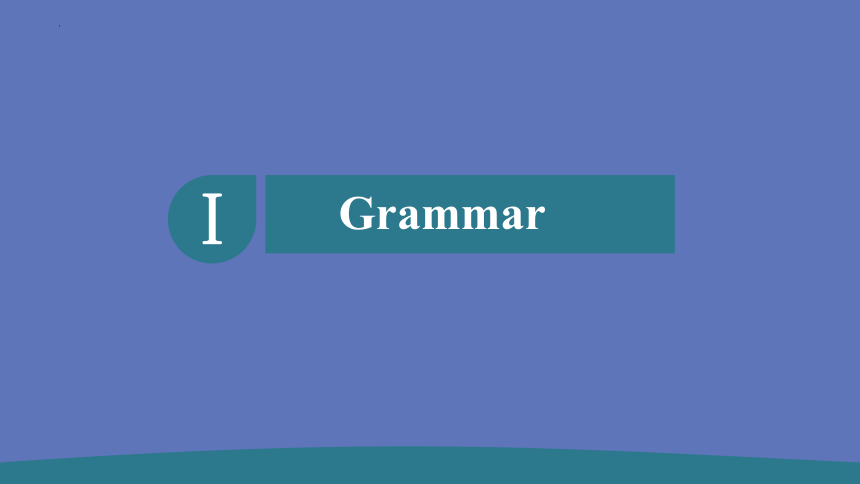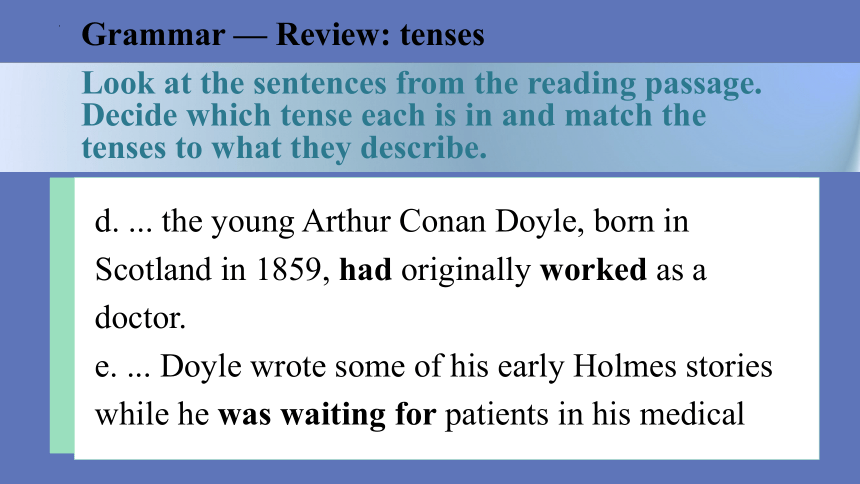高中英语外研版(2019)选择性必修第四册Unit 1 Looking forwards-Using language 课件(共26张PPT)
文档属性
| 名称 | 高中英语外研版(2019)选择性必修第四册Unit 1 Looking forwards-Using language 课件(共26张PPT) |  | |
| 格式 | zip | ||
| 文件大小 | 205.9KB | ||
| 资源类型 | 教案 | ||
| 版本资源 | 外研版(2019) | ||
| 科目 | 英语 | ||
| 更新时间 | 2022-08-03 09:50:28 | ||
图片预览









文档简介
(共26张PPT)
Using language
Unit 1 Looking forwards
目录
contents
Grammar — Review: tenses
Homework
Vocabulary building
Listening & speaking
I
II
III
Ⅳ
Ⅰ
Grammar
Grammar — Review: tenses
Look at the sentences from the reading passage. Decide which tense each is in and match the tenses to what they describe.
a. For many of us, it’s something we already have experienced.
b. What will we be doing in ten years’ time
c. He would later go on to win the Nobel Prize in Literature.
d. ... the young Arthur Conan Doyle, born in Scotland in 1859, had originally worked as a doctor.
e. ... Doyle wrote some of his early Holmes stories while he was waiting for patients in his medical
Grammar — Review: tenses
Look at the sentences from the reading passage. Decide which tense each is in and match the tenses to what they describe.
practice in London.
f. ... but Sherlock Holmes has been entertaining readers for well over a century.
Grammar — Review: tenses
Look at the sentences from the reading passage. Decide which tense each is in and match the tenses to what they describe.
1. An action completed in the past before another past action.
2. An action or event taking place over a particular period in the future.
3. An action that happened in a period of time up to the present.
a
b
d
Grammar — Review: tenses
Look at the sentences from the reading passage. Decide which tense each is in and match the tenses to what they describe.
Look at the sentences from the reading passage. Decide which tense each is in and match the tenses to what they describe.
4. An action that started in the past and may still be going on or have just stopped.
5. An intended future action or event as seen from the past.
6. An on-going situation at or around a particular time in the past.
e
c
f
Grammar — Review: tenses
1. What other tenses have you learnt Find examples in the reading passage.
①One moment, we are lying comfortably in bed, about to fall into a deep sleep.
②... we find ourselves wondering or even worrying about possibly the most important issue of our life
③Although they shared the same ambitious and energetic approach to life, ...
(Present Continuous)
(Present Simple)
(Past Simple )
Grammar — Review: tenses
2. What do these tenses describe
Present Continuous: to talk about actions happening now or around now; to be used for future arrangements
Present Simple: to be used for habits, permanent situations, and truth; to be used for the future for timetabled events, such as airplanes
Past Simple: to describe events in the past
Grammar — Review: tenses
时态
一般体
进行体
完成体
完成进行体
时态
一般现在时
一般过去时
一般将来时
过去将来时
现在进行时
过去进行时
将来进行时
现在完成时
过去完成时
现在完成进行时
Grammar — Review: tenses
1. 一般现在时的构成
一般现在时
一般现在时通常以动词原形表示,当主语是第三人称单数时,谓语一般由动词原形后加 -s 或 -es 构成。
Grammar — Review: tenses
2. 一般现在时的用法
一般现在时
①表示经常性、习惯性的动作或存在的状态,常与频度副词及表示现在的时间状语连用。
例如:
always 总是 often 经常 usually 通常 sometimes 有时 on Sundays 每逢周日
every day / week / month / year 每天/周/月/年
once / twice a week 每周一/两次
Grammar — Review: tenses
2. 一般现在时的用法
一般现在时
②表示主语目前的性格、特征、状态或能力等。
例如:He is a man of few words.
他是一个少言寡语的人。
She knows French and German besides English.
除了英语,她还会法语和德语。
Grammar — Review: tenses
2. 一般现在时的用法
一般现在时
③ 表示客观事实、普遍真理及自然现象,或用在格言中。
例如:The earth goes around the sun.
地球绕着太阳转。
Failure is the mother of success.
失败是成功之母。
Grammar — Review: tenses
2. 一般现在时的用法
一般现在时
④ 表示按规定、计划、安排、时间表等马上要发生的事情,常与具体的时间状语连用。该用法常用于火车时刻表、飞机航班时刻表,以及电影开演、作息、安排等时刻表上,且仅限于少数表示短暂意义的动词。
come 来 go 去 arrive 到达 leave 离开 begin 开始
start 开始 take off 起飞 finish 完成 stop 停止
例:The train leaves at 4:30 p.m. 火车在下午4:30出发。
The plane takes off at 5 o’clock. 飞机在5点钟起飞。
Grammar — Review: tenses
1. 一般过去时的构成
一般过去时
一般过去时由动词的过去式表示。
2. 一般过去时的用法
① 表示过去某一时间发生的动作或存在的状态,其中包括过去的习惯性动作,常与表示过去的时间状语连用。
例如:
yesterday 昨天 in 1990 在1990年
the other day 前几天 once upon a time 从前
last week / month / year 上周/上月/去年
Grammar — Review: tenses
一般过去时
2. 一般过去时的用法
② 描述过去时间内连续发生的动作。
例如:He opened his eyes, put on his clothes quickly and jumped down from the bed.
他睁开眼睛,迅速地穿上衣服,并从床上跳了下来。
Grammar — Review: tenses
一般过去时
2. 一般过去时的用法
例如:I didn’t know you were here.
我不知道你在这里。
③有些动作发生的时间没有具体表明,但实际上是“刚才,刚刚” 发生,应使用一般过去时。如 I didn’t know ... 或 I forgot ... 等表示事先或说话之前不知道或不记得,但现在已知道或记得的事情。
Grammar — Review: tenses
一般将来时
一般将来时的构成和用法
①表示将要发生的动作或将来存在的状态,shall 一般用于第一人称,will 可用于各种人称,常与表示将来的时间状语连用。
1. will / shall + 动词原形
例如:
tomorrow 明天 in the future 将来
later on 后来 the day after tomorrow 后天
next week / month / year 下周/下个月/明年
Grammar — Review: tenses
一般将来时
一般将来时的构成和用法
②will 还可表示说话时临时作出的决定。
1. will / shall + 动词原形
例如:— Shall I order a taxi for Sarah to go to the
airport tonight
— Don’t bother. I’ll drive her there.
Grammar — Review: tenses
一般将来时
一般将来时的构成和用法
表示按计划、打算要做某事;还可表示“预见”,即某种迹象预示着要发生某事。
2. be going to + 动词原形
例如:Whether in the home or the workplace, social robots are going to become a lot more common in the next few years. 无论是在家里还是在工作场所,未来的几年里社交机器人将会变得更加普遍。
Grammar — Review: tenses
一般将来时
一般将来时的构成和用法
表示按计划、约定或按职责、义务必须做的事或即将发生的动作。
3. be to + 动词原形
例如:The highway is to be opened in May.
这条高速公路将在5月份开放。
You are to hand in your papers by 10 o’clock.
10点前你们得上交论文。
Grammar — Review: tenses
一般将来时
一般将来时的构成和用法
表示立即要发生的动作,常译作“即将……;马上就……”,通常不与具体的时间状语连用。
4. be about to + 动词原形
例如:Work was about to start on a new factory building.
新厂房即将动工。
Grammar — Review: tenses
Ⅳ
Homework
Homework
1. Review the usage of tenses and do the relevant exercises.
2. Make up an interview using the words and expressions you’ve learnt today.
Using language
Unit 1 Looking forwards
目录
contents
Grammar — Review: tenses
Homework
Vocabulary building
Listening & speaking
I
II
III
Ⅳ
Ⅰ
Grammar
Grammar — Review: tenses
Look at the sentences from the reading passage. Decide which tense each is in and match the tenses to what they describe.
a. For many of us, it’s something we already have experienced.
b. What will we be doing in ten years’ time
c. He would later go on to win the Nobel Prize in Literature.
d. ... the young Arthur Conan Doyle, born in Scotland in 1859, had originally worked as a doctor.
e. ... Doyle wrote some of his early Holmes stories while he was waiting for patients in his medical
Grammar — Review: tenses
Look at the sentences from the reading passage. Decide which tense each is in and match the tenses to what they describe.
practice in London.
f. ... but Sherlock Holmes has been entertaining readers for well over a century.
Grammar — Review: tenses
Look at the sentences from the reading passage. Decide which tense each is in and match the tenses to what they describe.
1. An action completed in the past before another past action.
2. An action or event taking place over a particular period in the future.
3. An action that happened in a period of time up to the present.
a
b
d
Grammar — Review: tenses
Look at the sentences from the reading passage. Decide which tense each is in and match the tenses to what they describe.
Look at the sentences from the reading passage. Decide which tense each is in and match the tenses to what they describe.
4. An action that started in the past and may still be going on or have just stopped.
5. An intended future action or event as seen from the past.
6. An on-going situation at or around a particular time in the past.
e
c
f
Grammar — Review: tenses
1. What other tenses have you learnt Find examples in the reading passage.
①One moment, we are lying comfortably in bed, about to fall into a deep sleep.
②... we find ourselves wondering or even worrying about possibly the most important issue of our life
③Although they shared the same ambitious and energetic approach to life, ...
(Present Continuous)
(Present Simple)
(Past Simple )
Grammar — Review: tenses
2. What do these tenses describe
Present Continuous: to talk about actions happening now or around now; to be used for future arrangements
Present Simple: to be used for habits, permanent situations, and truth; to be used for the future for timetabled events, such as airplanes
Past Simple: to describe events in the past
Grammar — Review: tenses
时态
一般体
进行体
完成体
完成进行体
时态
一般现在时
一般过去时
一般将来时
过去将来时
现在进行时
过去进行时
将来进行时
现在完成时
过去完成时
现在完成进行时
Grammar — Review: tenses
1. 一般现在时的构成
一般现在时
一般现在时通常以动词原形表示,当主语是第三人称单数时,谓语一般由动词原形后加 -s 或 -es 构成。
Grammar — Review: tenses
2. 一般现在时的用法
一般现在时
①表示经常性、习惯性的动作或存在的状态,常与频度副词及表示现在的时间状语连用。
例如:
always 总是 often 经常 usually 通常 sometimes 有时 on Sundays 每逢周日
every day / week / month / year 每天/周/月/年
once / twice a week 每周一/两次
Grammar — Review: tenses
2. 一般现在时的用法
一般现在时
②表示主语目前的性格、特征、状态或能力等。
例如:He is a man of few words.
他是一个少言寡语的人。
She knows French and German besides English.
除了英语,她还会法语和德语。
Grammar — Review: tenses
2. 一般现在时的用法
一般现在时
③ 表示客观事实、普遍真理及自然现象,或用在格言中。
例如:The earth goes around the sun.
地球绕着太阳转。
Failure is the mother of success.
失败是成功之母。
Grammar — Review: tenses
2. 一般现在时的用法
一般现在时
④ 表示按规定、计划、安排、时间表等马上要发生的事情,常与具体的时间状语连用。该用法常用于火车时刻表、飞机航班时刻表,以及电影开演、作息、安排等时刻表上,且仅限于少数表示短暂意义的动词。
come 来 go 去 arrive 到达 leave 离开 begin 开始
start 开始 take off 起飞 finish 完成 stop 停止
例:The train leaves at 4:30 p.m. 火车在下午4:30出发。
The plane takes off at 5 o’clock. 飞机在5点钟起飞。
Grammar — Review: tenses
1. 一般过去时的构成
一般过去时
一般过去时由动词的过去式表示。
2. 一般过去时的用法
① 表示过去某一时间发生的动作或存在的状态,其中包括过去的习惯性动作,常与表示过去的时间状语连用。
例如:
yesterday 昨天 in 1990 在1990年
the other day 前几天 once upon a time 从前
last week / month / year 上周/上月/去年
Grammar — Review: tenses
一般过去时
2. 一般过去时的用法
② 描述过去时间内连续发生的动作。
例如:He opened his eyes, put on his clothes quickly and jumped down from the bed.
他睁开眼睛,迅速地穿上衣服,并从床上跳了下来。
Grammar — Review: tenses
一般过去时
2. 一般过去时的用法
例如:I didn’t know you were here.
我不知道你在这里。
③有些动作发生的时间没有具体表明,但实际上是“刚才,刚刚” 发生,应使用一般过去时。如 I didn’t know ... 或 I forgot ... 等表示事先或说话之前不知道或不记得,但现在已知道或记得的事情。
Grammar — Review: tenses
一般将来时
一般将来时的构成和用法
①表示将要发生的动作或将来存在的状态,shall 一般用于第一人称,will 可用于各种人称,常与表示将来的时间状语连用。
1. will / shall + 动词原形
例如:
tomorrow 明天 in the future 将来
later on 后来 the day after tomorrow 后天
next week / month / year 下周/下个月/明年
Grammar — Review: tenses
一般将来时
一般将来时的构成和用法
②will 还可表示说话时临时作出的决定。
1. will / shall + 动词原形
例如:— Shall I order a taxi for Sarah to go to the
airport tonight
— Don’t bother. I’ll drive her there.
Grammar — Review: tenses
一般将来时
一般将来时的构成和用法
表示按计划、打算要做某事;还可表示“预见”,即某种迹象预示着要发生某事。
2. be going to + 动词原形
例如:Whether in the home or the workplace, social robots are going to become a lot more common in the next few years. 无论是在家里还是在工作场所,未来的几年里社交机器人将会变得更加普遍。
Grammar — Review: tenses
一般将来时
一般将来时的构成和用法
表示按计划、约定或按职责、义务必须做的事或即将发生的动作。
3. be to + 动词原形
例如:The highway is to be opened in May.
这条高速公路将在5月份开放。
You are to hand in your papers by 10 o’clock.
10点前你们得上交论文。
Grammar — Review: tenses
一般将来时
一般将来时的构成和用法
表示立即要发生的动作,常译作“即将……;马上就……”,通常不与具体的时间状语连用。
4. be about to + 动词原形
例如:Work was about to start on a new factory building.
新厂房即将动工。
Grammar — Review: tenses
Ⅳ
Homework
Homework
1. Review the usage of tenses and do the relevant exercises.
2. Make up an interview using the words and expressions you’ve learnt today.
